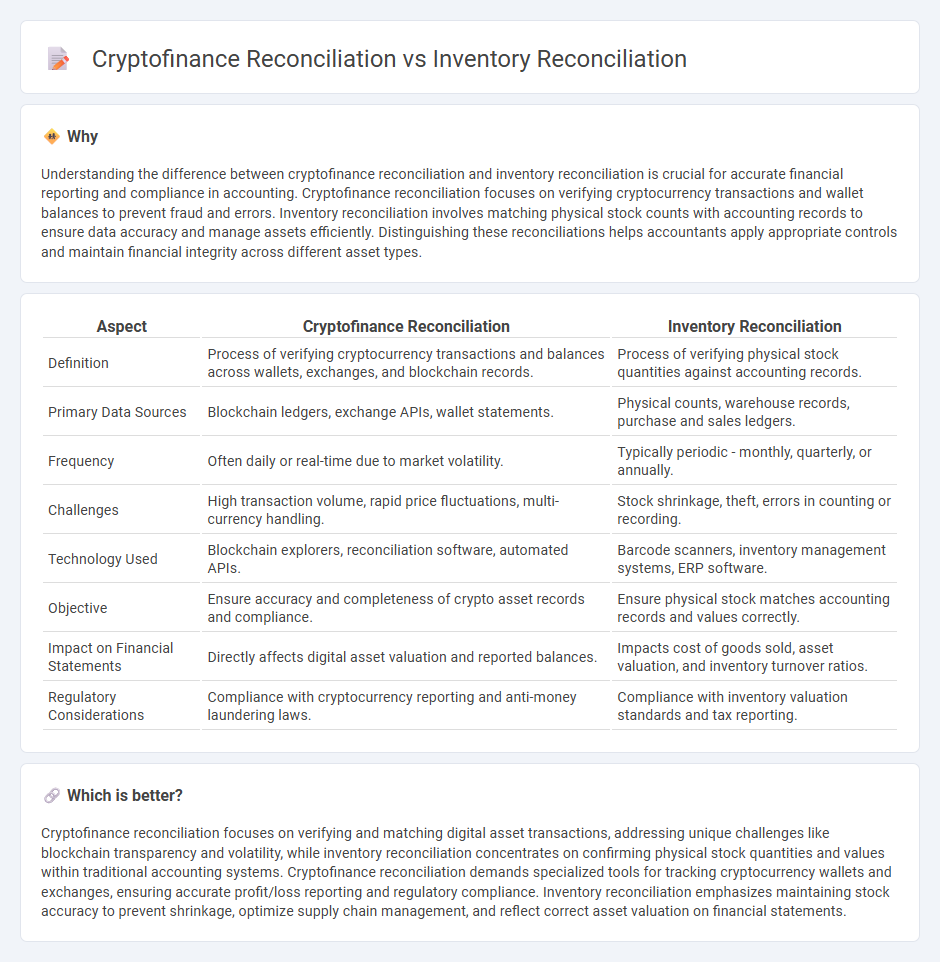
Cryptofinance reconciliation involves verifying cryptocurrency transactions to ensure accuracy between wallets and ledgers, addressing unique challenges like volatility and blockchain confirmation times. Inventory reconciliation focuses on matching physical stock counts with recorded quantities in accounting systems, critical for preventing stock discrepancies and financial misstatements. Explore more about how both reconciliation methods enhance financial accuracy in their respective domains.
Why it is important
Understanding the difference between cryptofinance reconciliation and inventory reconciliation is crucial for accurate financial reporting and compliance in accounting. Cryptofinance reconciliation focuses on verifying cryptocurrency transactions and wallet balances to prevent fraud and errors. Inventory reconciliation involves matching physical stock counts with accounting records to ensure data accuracy and manage assets efficiently. Distinguishing these reconciliations helps accountants apply appropriate controls and maintain financial integrity across different asset types.
Comparison Table
| Aspect | Cryptofinance Reconciliation | Inventory Reconciliation |
|---|---|---|
| Definition | Process of verifying cryptocurrency transactions and balances across wallets, exchanges, and blockchain records. | Process of verifying physical stock quantities against accounting records. |
| Primary Data Sources | Blockchain ledgers, exchange APIs, wallet statements. | Physical counts, warehouse records, purchase and sales ledgers. |
| Frequency | Often daily or real-time due to market volatility. | Typically periodic - monthly, quarterly, or annually. |
| Challenges | High transaction volume, rapid price fluctuations, multi-currency handling. | Stock shrinkage, theft, errors in counting or recording. |
| Technology Used | Blockchain explorers, reconciliation software, automated APIs. | Barcode scanners, inventory management systems, ERP software. |
| Objective | Ensure accuracy and completeness of crypto asset records and compliance. | Ensure physical stock matches accounting records and values correctly. |
| Impact on Financial Statements | Directly affects digital asset valuation and reported balances. | Impacts cost of goods sold, asset valuation, and inventory turnover ratios. |
| Regulatory Considerations | Compliance with cryptocurrency reporting and anti-money laundering laws. | Compliance with inventory valuation standards and tax reporting. |
Which is better?
Cryptofinance reconciliation focuses on verifying and matching digital asset transactions, addressing unique challenges like blockchain transparency and volatility, while inventory reconciliation concentrates on confirming physical stock quantities and values within traditional accounting systems. Cryptofinance reconciliation demands specialized tools for tracking cryptocurrency wallets and exchanges, ensuring accurate profit/loss reporting and regulatory compliance. Inventory reconciliation emphasizes maintaining stock accuracy to prevent shrinkage, optimize supply chain management, and reflect correct asset valuation on financial statements.
Connection
Cryptofinance reconciliation and inventory reconciliation are connected through their shared goal of ensuring accurate financial records and asset tracking within a business. Both processes involve matching transactional data from different sources--cryptofinance reconciliation aligns cryptocurrency transaction records with blockchain and accounting systems, while inventory reconciliation compares physical stock counts with inventory management records. Effective reconciliation in these areas enhances financial transparency, reduces discrepancies, and supports compliance with accounting standards and regulatory frameworks.
Key Terms
**Inventory reconciliation:**
Inventory reconciliation involves systematically comparing physical stock counts with recorded inventory data to identify discrepancies, ensuring accuracy in financial reporting and operational efficiency. This process utilizes tools like barcode scanners and inventory management software to track quantities, locations, and conditions of goods. Explore how inventory reconciliation enhances supply chain accuracy and reduces financial risks.
Stock count
Inventory reconciliation involves physically counting stock items to verify quantities against recorded data, ensuring accuracy in warehouse management systems. Cryptofinance reconciliation focuses on digital asset verification, matching blockchain transactions with ledger entries to prevent discrepancies. Explore deeper insights into these reconciliation processes to optimize accuracy and control.
Discrepancy
Inventory reconciliation involves verifying physical stock against recorded inventory to identify discrepancies such as missing, damaged, or excess items that impact financial accuracy. Cryptofinance reconciliation focuses on cross-verifying blockchain transactions with internal records to detect discrepancies like unrecorded transfers or transaction mismatches, which can indicate fraud or errors. Explore how advanced reconciliation techniques address discrepancy challenges to enhance accuracy in both fields.
Source and External Links
How to reconcile inventory - Inventory reconciliation is the detailed process of comparing on-hand inventory to recorded amounts, identifying discrepancies, and adjusting records accordingly to maintain accurate inventory tracking and prevent recurring errors.
How to Reconcile Your Inventory in 6 Steps (2024) - Inventory reconciliation involves physically counting stock and comparing it to system records, then updating the system to reflect the actual quantities on hand for accurate inventory management.
Inventory Reconciliation: How to Reconcile Your ... - The process includes recounting inventory, comparing physical counts to records, investigating causes of discrepancies such as errors or missing paperwork, and then adjusting records and processes to maintain inventory accuracy.
 dowidth.com
dowidth.com